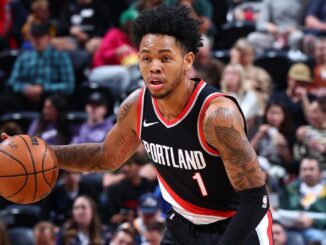
The Portland Trail Blazers’ 2016-17 season was a year defined by high ambitions and unmet expectations. The team saw a regression to the norm after shocking the league just a year prior, but there is plenty of talent on the roster that can help it improve.
Ahead of 2017-18, Oregon Sports News’ Jared Wright and Bryant Knox will be breaking down the strengths, weaknesses and recent showings from each and every Trail Blazers player. Today we take a look at a veteran hoping to prove he’s not only healthy, but that he can outplay the team’s young bigs as he enters a contract season.
2016-17 Recap
| GP | GS | MPG | PPG | FG% | FT% | RPG | BPG | APG |
| 46 | 12 | 17.2 | 4.3 | 52.8 | 61.7 | 5.3 | 0.5 | 0.6 |
The 2016-17 campaign was an underwhelming one for Ed Davis. He played his final game on Feb. 23, saw a number of DNPs before that, and eventually underwent surgery to repair a torn labrum.
“It got to a point where I couldn’t go up and make five layups in a row with my left hand,” Davis said at Trail Blazers Media Day.
That, for a left-handed big man, is less than ideal.
The catch in all of this is that Davis’ numbers were underwhelming all season. Even before he got hurt, there was a bit of disappointment watching him play considering he’d been a dominant force in the paint on one of the league’s most reasonable contracts just the year before.
Although Davis failed to live up to expectations—a reality the Trail Blazers at large were met with—he had the luxury of knowing he was coming back with one year left on his deal.
This season, he doesn’t have that, as he risks being a tax-dump candidate if he performs at the same level.
What He Brings To The Table
The Blazers have an enforcer in Davis. That’s not a descriptor used lightly considering the late Maurice Lucas is known as the true Enforcer around these parts, but there’s also a reason Davis has earned the nickname Phys Ed.
“Ed’s about the right things,” Terry Stotts told media members at training camp. “He defends, he brings energy, you feel his presence, and I think for players and coaches alike, just having him out there, it’s refreshing, but I think everybody also feels good for him, because it was a long seven months for him.”
At the rim, the former UNC Tar Heel is effective on both ends of the floor. He’s an elite rebounder, he blocks shots and he’s an efficient scorer at the cup.
The problem is that Davis, despite being just 28 years old, has become something of a relic in today’s game. He doesn’t spread the floor, he’s not a point-forward unicorn and, according to Basketball-Reference, he’s shot just 27.1 percent between 3-10 feet and 11.9 percent from 10-16 feet for his career.
Then again, Davis knows what he does well and doesn’t force it. Last season, his average shot distance was 2.5 feet from the rim.
The next-closest average was Jusuf Nurkic at 4.9, which is starkly different from Meyers Leonard, whose 18.9 feet was the furthest on the team.
What To Expect in 2017-18
At media day, Davis was asked where he sees himself fitting in considering the competition he has in the frontcourt. In his own words, “I want to start.”
Davis backed off that statement a bit as the conversation went on, but he made it clear that he’s not on the roster to ride the bench.
“It’s a good thing as a player when you know it’s a chance that you could start and play big minutes … point guard position, you know Dame, he’s gonna play 35-plus minutes a game. But I feel with the 4 position, it’s open.”
In today’s day and age of pace-and-space and floor-stretching bigs, Davis doesn’t look like a starter. His game, at least on this roster, feels more like it’s best suited to either play the 4 when Meyers Leonard is at the 5, or at center when someone like Noah Vonleh or Al-Farouq Aminu is at power forward.
If Davis can come out of the gate, stay healthy and show he’s just as physical at the rim as always, he’ll carve out a niche as the team’s resident tough guy. Then again, if he can’t, he could prove to be little more than trade fodder in a contract year, leaving both present and future frontcourt duties to his younger counterparts.
Check out the other articles of this series down below:



